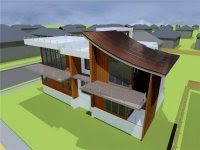


Back in the day, buildings had to engage their climate in order to be efficient. Porches, overhangs, and the site, all had to work together to address the needs of the inhabitants. Then along came modern heating and ventilation systems, and quickly buildings no longer took environmental needs into account. Inefficient buildings account for 48% of all energy consumption in the United States, so it makes great sense to set goals and incentives to decrease the carbon footprint of our buildings.
This is not some fantasy initiative. Bouler Architecture's Oak Beach project generated more power in its first year than it consumed, making it better than a zero energy structure, but as it stands, it takes a special, forward-thinking client to take on such a goal. Local building codes, however, should take note. With a combination of alternative energy systems, comfort doesn't have to be lost to be efficient. Creative engineering which addresses the microclimate of the site can alleviate the need for turning on the AC or the heat. Towns should consider giving tax breaks to encourage alternative energy sources and eco-friendly landscaping elements, as well as setting incremental guidelines to encourage homeowners to invest in greening their homes. With the cost of off-shore drilling at $700 million dollars a rig, spills notwithstanding, it's hard to believe that making a building more like a machine isn't a cost-effective way to move into the future.





No comments:
Post a Comment